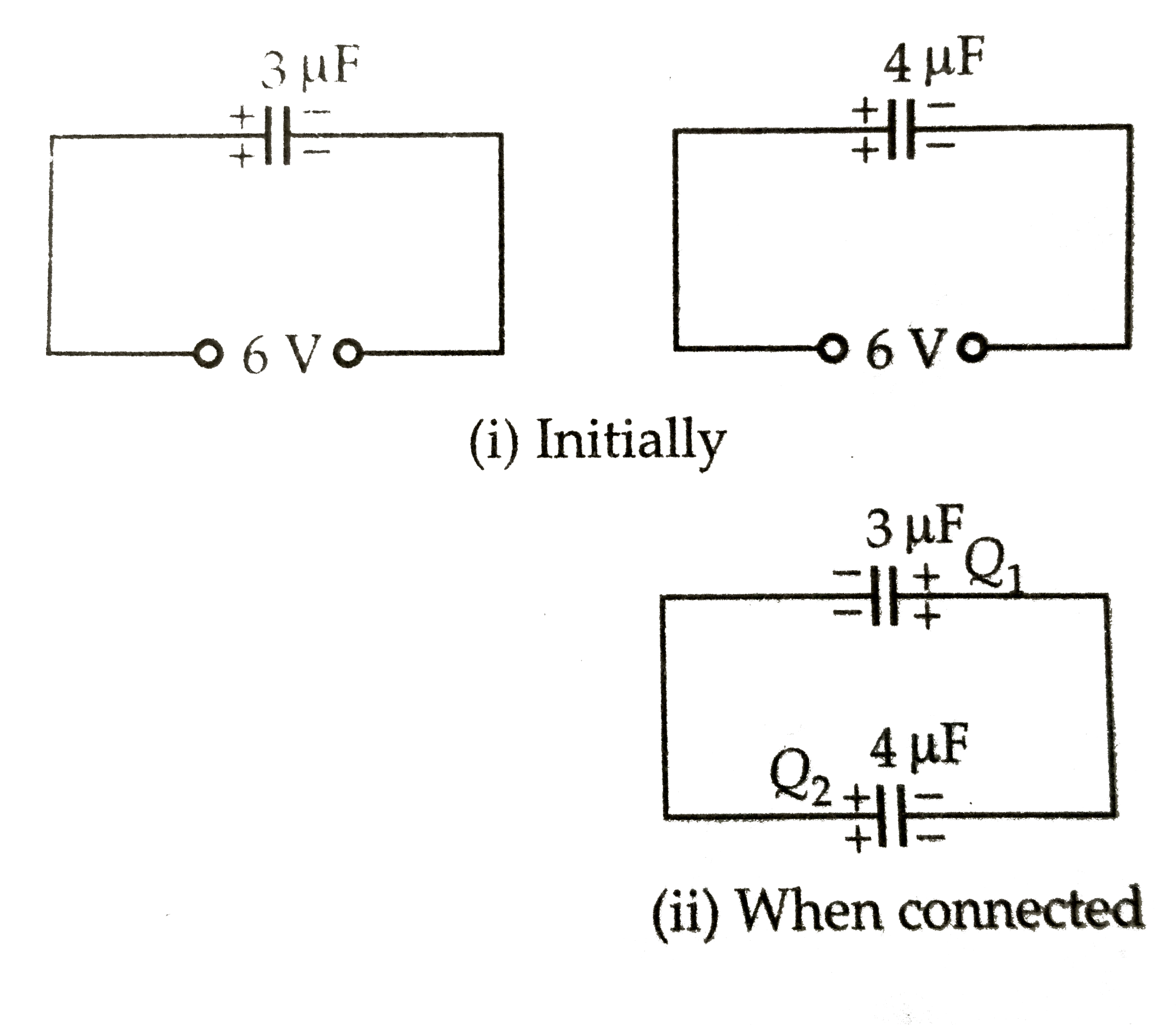Two capcitors, 3 μF and 4μF, are individually charged across a 6 V battery. After being disconnected from the battery, they are connected together with the negative plate of one attached to the positive plate of the other. What is the final total energy stored ?
1.26×10−4J
2.57×10−4J
1.25×10−6J
2.57×10−6J
The correct Answer is:D
As Q = CV
∴ Initially the charge on each capacitor is
Q1=C1V1=(3μF)(6V)=18μC
and Q2=C2V2=(4μF)(6V)=24μC
When two capacitor is are joined to each other such that negative plate of one is attached with the positive plate of the other . The charges Q1 and Q2 are redistributed till they attain the common potential which is given by .
Common potential V=Total ChargeTotal capacitance
=24μC−18μC3μF+4μF=67V
Final energy stored,
Uf=12(C1+C2)V2=12[3×10−6+4×10−6]×(67)2
=12×7×10−6×3649=2.57×10−6J

Topper's Solved these Questions
- ELECTROSTATIC POTENTIAL AND CAPACITANCE BOOK - NCERT FINGERTIPSCHAPTER - ELECTROSTATIC POTENTIAL AND CAPACITANCE EXERCISE - Van De Graaff Generator
5 Videos
- ELECTROSTATIC POTENTIAL AND CAPACITANCE BOOK - NCERT FINGERTIPSCHAPTER - ELECTROSTATIC POTENTIAL AND CAPACITANCE EXERCISE - Higher Order Thinking Skills
8 Videos
- ELECTROSTATIC POTENTIAL AND CAPACITANCE BOOK - NCERT FINGERTIPSCHAPTER - ELECTROSTATIC POTENTIAL AND CAPACITANCE EXERCISE - Combination Of Capacitors
14 Videos
- ELECTROMAGNETIC WAVESBOOK - NCERT FINGERTIPSCHAPTER - ELECTROMAGNETIC WAVESEXERCISE - Assertion And Reason
15 Videos
- MAGNETISM AND MATTER BOOK - NCERT FINGERTIPSCHAPTER - MAGNETISM AND MATTER EXERCISE - Assertion And Reason
15 Videos
Similar Questions
Three capacitors of capacitances 4μF,6μF and 12μF are connected in series with a 110V battery. The battery is disconnected,the three positive plates are connected together and the three negative plates are connected together. Find the charges on the three capacitors arter the reconnection.
View SolutionTwo parallel plates capacitors A and B having capacitance of 1μFand5μF are charged separately to the same potential of 100 V. Now, the positive plate of A is connected to the negative plate of B and the negative plate of A to the positive plate of B. Find the final charges on each capacitors.
View Solution
Knowledge Check
Two capacitors, 3μF and 4μF, are individually charged across a 6V battery. After being disconnected from the battery, they are connected together with the negative place of one attached to the positive plate of the other. What is the common potential?
A6VB(67)VC2VD(32)VA 5μF capacitor is fully charged across a 12 V battery, It is then disconnected from the battery and connected to an uncharged capacitor, If the voltage across the capacitor becomes 3 V then the capacitance of the
A3μFB15μFC25μFD60μFTwo capacitors of capacitances 3μF and 6μF are charged to a potential of 12V each. They are now connected to each other, with the positive plate of each joined to the negative plate of the other. The potential difference across each will be
A6 voltB4 voltC3 voltDZero
Two capacitors of capacitance 2μF and 4μF respectively are charged to a potential of 12 V. they are now connected to each other, with the positive plate of each joined to the negative plate of the other. The potential difference across each capacitor will be
View SolutionThree capacitors of capacitances 2μF, 3μF and 6μF are connected in series with a 12 V battery. All the connecting wire are disconnected, the three positive plates are connected together and the three negative plates are connected together. Find the charges on the three capacitors after the reconnection.
View SolutionA 8μF capacitor is fully charged across a 12V battery, it is then disconnected from the battery and connected to an uncharged capacitor. If the voltage across the capacitor becomes 3V, then the capacitance of the uncharged capacitor will be
View SolutionA 5μF capacitor is placed across a 12 V battery. It is disconnected from the battery and connected across a condenser of unknown capacity. The voltage then is found to be 3V. The value of the unknownn capacity is
View SolutionTwo capacitors of capacitances 1μFand3μF are charged to the same voltages 5V. They are connected in parallel with oppositely charged plates connected together. Then
View Solution
